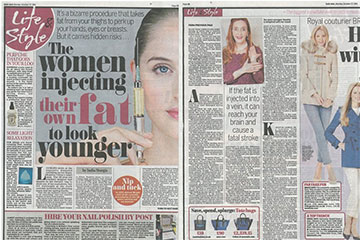
The women injecting their own fat to look younger
FAT TRANSFER
Daily Mail
Looking down at the exquisite diamond twinkling on her finger, Rosetta Citton’s heart sank. The 59-year-old jewellery designer had slipped on the eternity ring to show one of her customers, but felt distraught at the stark contrast between the glittering stone and her ageing hands.
“That was the moment I knew I had to do something” says the married mother-of-three from London. “My hands looked gaunt and gnarled. My tendons were raised and the skin was as shrivelled as tissue paper. I had to find a way to change them – for my business as well as myself.”
But rather than opt for hand creams or fillers, Rosetta chose to have a cutting-edge procedure that sounds as if it’s straight from the pages of a sci-fi novel: a fat graft, where fat was sucked from her thighs and injected into her hands to plump them up.
Billed as a natural and long-lasting alternative to implants and fillers, these fat grafts – also used to plump up sagging boobs, or a bottom that has lost its perkiness – have become big business since being pioneered in the U.S. In the past year, the British Association of Aesthetic Plastic Surgeons has reported a 15 per cent increase in the number of treatments.
The two-in-one procedure, which costs from £1,500 to £15,000, involves removing anything from 20ml to 200ml (a third of a pint) of fat from most commonly the inner thigh or stomach, slimming the area slightly in the process. It’s then injected into somewhere lacking in volume, such as the breasts, buttocks, eye area or hands.
The treatment requires only local anaesthetic and patients are discharged the same day. While a certain amount of the newly-added fat gets reabsorbed by the body, most stays in place, ageing and depleting naturally alongside other body cells. Scarring is kept to a minimum as the skin need only be pierced with a small syringe.
As fat is softer and more fluid than synthetic fillers, the results from fat grafting look and feel natural, and there’s no risk of rejection. It stays in its new ‘home’ unless you lose weight quickly, in which case it behaves exactly like normal fat and gets broken down and reabsorbed. As a result, effects can last ten years or more compared to fillers which typically need replacing after 12 months.
Rosetta opted for the extraordinary procedure after visiting Harley Street’s The Private Clinic, where four years earlier she’d had fillers injected into her face. She arrived expecting the same treatment, but aesthetic surgeon Dr. Dennis Wolf suggested a £1,850 fat graft might give better results.
Dr Wolf has already treated three times as many people this year as last for fat transfers to their hands. Despite the fact she was conscious throughout, Rosetta says she wasn’t squeamish: ‘It didn’t hurt save for a slight burning sensation as the anaesthetic first took hold.’
First, local anaesthetic was injected into the upper back part of her thighs and hands. Fat is usually taken from somewhere that the patient has excess fat to lose; on thinner people (Rosetta is a size 8) that’s usually the thigh.
A small incision was then made in her skin and 20ml of fat – about four teaspoons – was sucked out and deposited into a machine which seperates healthy fat cells from ones damaged during extraction. The purified fat cells were then injected into the back of Rosetta’s hands. She was in and out within 90 minutes and back at work in four days. Eighteen months later, she’s still delighted with the results.
“My hands still look ten years younger. They have volume, seem healthier and smoother and the wrinkles are reduced. I don’t see it as an act of vanity as it’s natural; you’re just taking fat from one place you don’t need it and moving it to somewhere you do.”
Dr Wolf estimates that 40 percent of fat injected won’t survive past the first month. “The fat cells can die if they aren’t near enough to a blood supply to sustain them, so we always over-fill to compensate”, he says. This can cause initial swelling which usually settles down within days or weeks depending on how much fat has been transferred.





